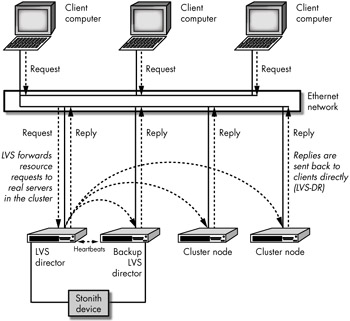The High-Availability LVS-DR Cluster
In this chapter, we will describe how to build a Linux Enterprise Cluster that uses the LVS-DR forwarding method in conjunction with the Heartbeat package for high availability.
A diagram of a highly available LVS cluster with two Directors is shown in Figure 15-1. The Directors, real servers, and client computers are all connected to the same network segment. The short dotted arrow connecting the LVS Director and the backup LVS Director in this figure represents a separate physical connection for heartbeats.

Figure 15-1: A highly available DR cluster
Using this configuration, the heartbeats can pass over the normal Ethernet network and a dedicated network or serial cable connection between the LVS Director and the backup LVS Director. Recall from Chapter 6 that heartbeats should be able to travel over two physically independent paths between the servers in a high-availability server pair.[4]
This diagram also shows a Stonith device (as described in Chapter 9) that provides true high availability. The backup node has a serial or network connection to the Stonith device so that Heartbeat can send power reset commands to it. The primary node has its power cable plugged into the Stonith device.[5]
The dashed gray arrows that originate from the LVS Director and point to each cluster node represent incoming packets from the client computers. Because this is an LVS-DR cluster, the reply packets are sent directly back out onto the Ethernet network by each of the cluster nodes and directly back to the client computers connected to this Ethernet network.
As processing needs grow, additional cluster nodes (LVS real servers) can easily be added to this configuration,[6] though two machines outside the cluster will always act as a primary and backup Director to balance the incoming workload.
[4]Avoid the temptation to put heartbeats only on the real or public network (as a means of service monitoring), especially when using Stonith as described in this configuration. See Chapter 9 for more information
[5]See Chapter 9 for a discussion of the limitations imposed on a high availability configuration that does not use two Stonith devices.
[6]Using the SystemImager package described in Chapter 5.
EAN: 2147483647
Pages: 219